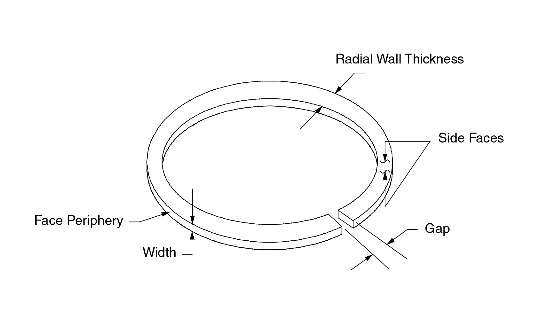MAHLE Clevite Inc. is in the process of transitioning its ring sets from a grey cast iron top rings to a carbon steel top rings. They say the advantages include 35% more strength, 30% less weight and double the resistance to side wear which is a common problem on late-model engines.
 The net result is a ring that’s lighter, so it has a higher effective rpm potential, stronger – so that it weathers the abuse of today’s high output engines better, and actually seals better because the reduced radial wall allows it to conform to the cylinder wall better.
The net result is a ring that’s lighter, so it has a higher effective rpm potential, stronger – so that it weathers the abuse of today’s high output engines better, and actually seals better because the reduced radial wall allows it to conform to the cylinder wall better.
Having said all that, there’s some additional explanation needed when it comes to back clearance – that area behind the ring which is calculated by subtracting the ring radial wall width from the root depth of the ring groove in the piston. For example; if you have a ring radial wall of .170” and a groove depth of .195˝ then your back clearance is .025˝.
Reducing the radial wall of the replacement carbon steel rings does increase the back clearance because they are going into piston grooves designed for the thicker radial wall of the cast iron rings.
It’s been a well-accepted piston/ piston ring engineering design criteria, that for optimum performance, ring back clearance should be minimized. This comes from the fact that the top compression ring needs the pressure from the combustion gases to get in behind the ring and push out on the ring to maintain proper seal on the high pressure, or combustion stroke.
The logic was that the smaller the area created by the back clearance, the quicker that pressure would build to push out on the ring, and the quicker the ring would react to its sealing requirements job. That logic is all good but what about the reality of the concept?
Since MAHLE makes both components in this equation – pistons and the rings, their piston ring R&D lab did some testing in conjunction with one of its OE customers to see if engine testing could reveal what the right amount of back clearance should be. What the lab folks found surprised most everyone! The engine wasn’t nearly as sensitive to ring back clearance as it was to ring side clearance.
The reason was the gases have to get past the top side of the ring in order to get around to the back of the ring to push out on it. When they tightened up the side clearance to less than .001", the ring went unstable even at normal operating rpms.
Blowby, which is gas leaking past the face of the ring, increased dramatically. Changing the back clearance didn’t show anything, negatively or positively either direction. It came down to having enough side clearance to let the gases flow back to the back of the ring not how much back clearance there was.
In any cylinder, you have hundreds of cc’s of gases available to fill that relatively small volume behind the ring (0.4 cc’s), Those gases are at a very high pressure, several hundred, or even thousand psi, so they will fill the small space behind the ring very quickly if you give them enough room (i.e., side clearance, to get there).
Most OE and aftermarket side clearance specs are in the .0015" – .0025" range. For regular, non-racing applications; changing from a cast iron top ring to a steel top ring won’t cause any adverse effect at all from the increased back clearance because the side clearance is adequate to allow the gas movement. Remember, we have hundreds of cc’s of gas to fill the very small amount of space change.
The performance engine builders are a different story, but they take care of the issue with custom groove specs. MAHLE’s performance ring catalog supplies radial wall specifications for every ring for just that reason. Many of the true high performance engine builders specify ring grooves with less than .001" side clearance, but they add gas ports, small channels drilled in the piston, either from the top or side of the piston, to give a direct path for those combustion gasses to get directly to the back side of the ring. The engine doesn’t care how the gases get back behind the ring, it only cares that it does, and in enough volume and pressure to do the job.
In summary, you can replace cast iron top rings with carbon steel, get all the benefits we’ve talked about in this bulletin, and rest assured companies such as Mahle Clevite have done their homework on the engineering side!
Tech Tip courtesy of MAHLE Clevite.
